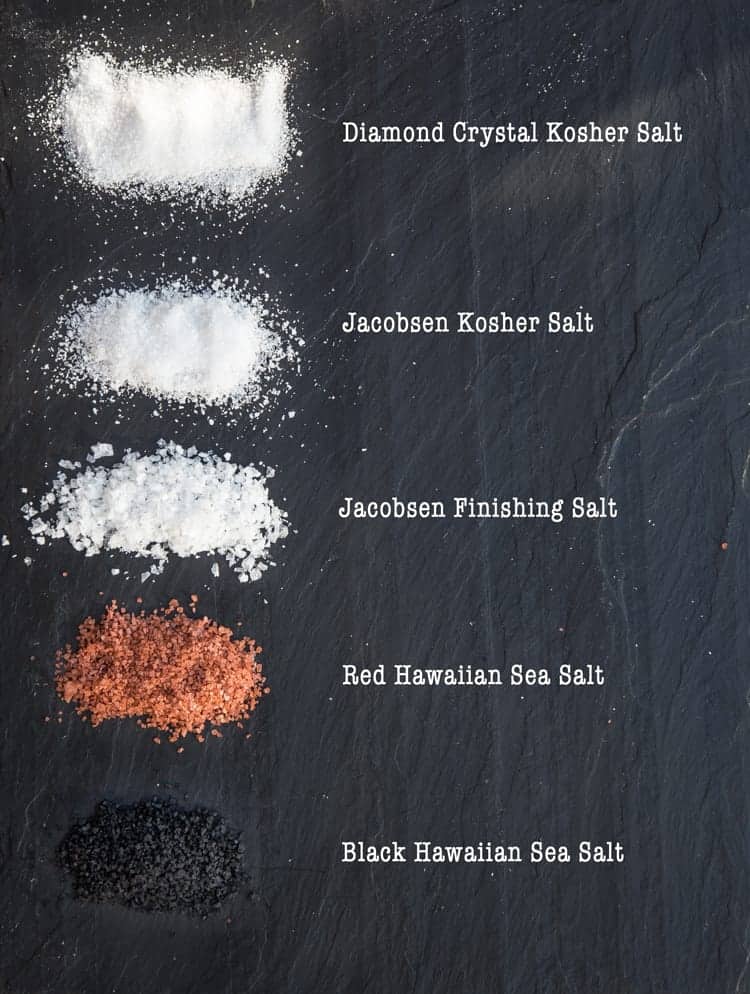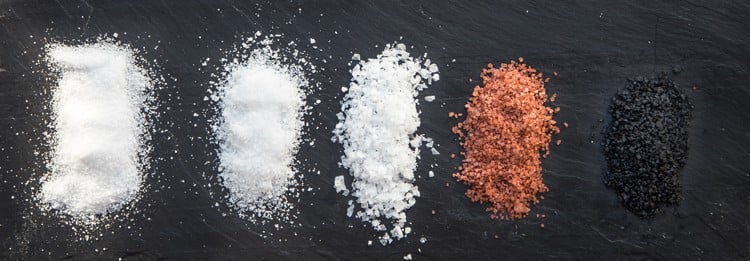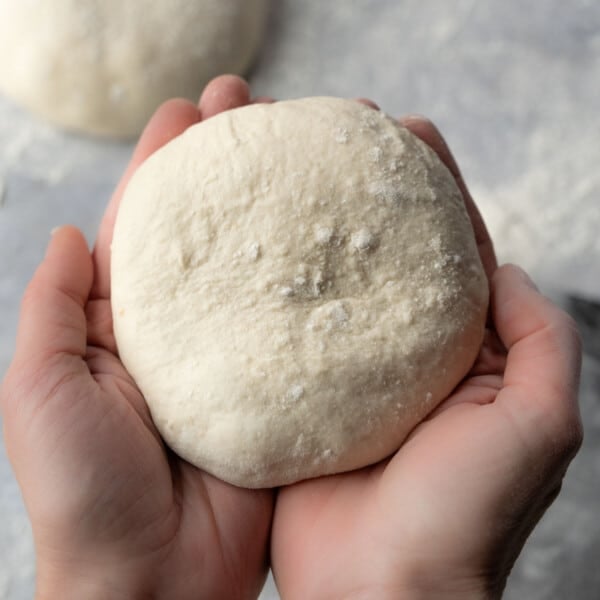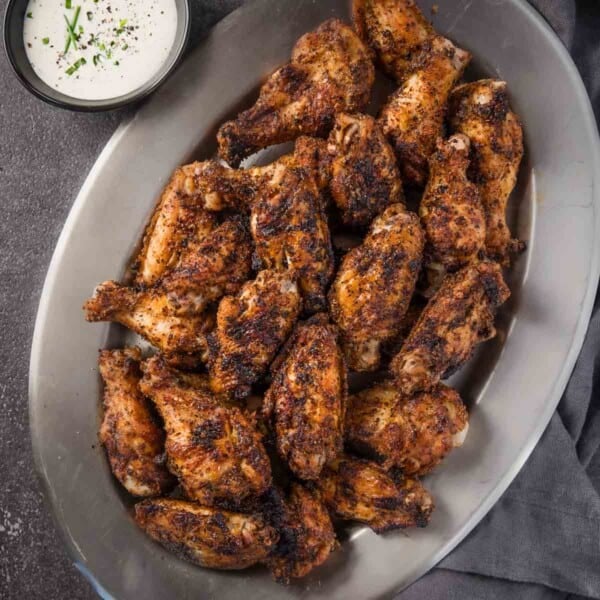Cooking With Sea and Kosher Salt
Jan 06, 2020, Updated Jan 16, 2024
This post may contain affiliate links. Read more at our disclosure policy.
Kosher Salt is the glue to many great culinary dishes, and a great way to add a finishing touch of flavor to a dish. We’ll explain what sea versus kosher salt is, and why you may want to consider these versus standard table salt.

Table of Contents
Is All Salt Sea Salt?
Virtually all salt is sea salt, or comes from oceans. Sea salt deposits from ages ago developed from ancient ocean beds. So technically all salts are sea salts.
Types of Salt for Cooking
There are different types of salt to know, especially when cooking. But in the end, the chemical element of salt is NaCl (Sodium Chloride). Where the salt comes from may also indicate trace minerals in the salt giving more unique flavor or color. Throughout our recipes, here is how we refer to most of the salts.
- Table Salt – Finer crystals that have been mined from salt quarries, and then cleaned of all trace minerals. This type of salt is potentially infused with iodide (a component of iodine) or anti-caking agent. This was done to prevent goiter. We don’t use table salt in our recipes for cooking or seasoning, opting for other varieties with more pronounced flavor and salt intensity.
- Sea Salt – Salt from the salt water that has gone through stages of evaporation to extract the crystals. There are several quality levels of sea salt depending on when it is harvested. Often the name of the salt is going to represent where it comes from around the world. This can include finishing salts.
- Kosher Salt – Either mined or sea salt used for koshering process with a very specific size crystal. This is the best option for making dry rubs and for seasoning proteins, like meat, due to the size of the grains.
- Rock Salt – Salt that comes from the earth in rocky deposits that were formerly seas. So technically is that sea salt? Yes. Examples include Himalayan black or pink salt.
Author Mark Kurlansky goes deep into this subject in his book, Salt: A World History. This book takes an in-depth look at the history of the “rock we eat” and explains how it became such an important part of our historical diet. A must read for any foodie wanting to go deep on the topic!
What is Kosher Salt?
Kosher salt is a salt used in the koshering process. The name is a reference to a specific size of crystal, ideal for salting meat in that koshering process to remove the blood or moisture from meat. This does not necessarily mean the salt brand is indeed “kosher”.
Over time Chef’s have come to appreciate the size of the crystals throughout the cooking process from creating a brine, salting water for pasta, to flavoring the dish itself.
The most common brands of Kosher Salt in the market, in no particular order, are:
- Diamond Crystal
- Morton
- Jacobsen
But before you assume they are all the same, let’s understand a little more about Kosher salt versus some of the other styles, most specifically sea salt.

Would you like to save this?
What is the difference between Kosher Salt and Sea Salt
Technically kosher salt is sea salt, but some brands will have made it by refining salt water, while others may have mined it. It will be either mined and refined through various techniques or extracted from sea water. The process of getting salt from the sea means that there are varying sizes of salt from fine sand like particles to large coarser versions. As noted above, the kosher variety is sought for its specific size for the koshering process.
Sea Salt
Sea Salt comes in many varieties. A few highlights include:
- Coarse Salts – These are the largest of the salt crystals and often come in grinders, to be used when seasoning raw meat or other proteins.
- Gray Salt – Smaller in texture than coarse, gray salt has trace minerals from the salt ponds in which it came from. Generally gray salt may also contain trace minerals, and is another alternative for dry rubs and seasoning raw meat.
- Flake or Finishing Salts – With a more refined process, the uniform pyramid shape of flake salts is a more time consuming process, and is very delicate. As a result, flake salt can be much more expensive for the consumer. These are great to serve over salads, because of the texture and fresh flavor. These are not recommended to use when seasoning raw meat, but rather as a “finishing” salt. Examples include, Maldon, Fleur de Sel, or Jacobsen finishing salt
- Flavored Salts – These are salts that have been smoked, or contain additive ingredients, like truffle oil, to enhance its flavor profile and to be used with more specific dishes, like popcorn or buttered bread.
- Himalayan Salt – These are blocks or large crystals that have been refined from mines. This is technically a rock salt, as it has been hardened over time. These have a unique color from trace chemicals that were left as the salt hardened. The flavor of Himalayan salt is intense, and often these salt blocks can be used for grilling or even as decorative serving plates.
How is Sea Salt Made
The most common method is salt pools along coastal areas where the sea water is contained and can evaporate slowly over time or through brining methods. In some cases there are terraces or a pool, in others there is a vessel the salt water is pumped into and heated. As the water evaporates, the salt is then harvested from the pools or harvested from the brining vessels.
It can be harvested naturally from the floor of pools, or skimmed off as the water evaporates using tools like pans.

When to use Kosher Salt In Recipes
We use Kosher salt in most of our recipes, unless otherwise specified. As you cook, we recommend finding one salt brand that works for your taste preferences and budget and stick with it. This is because even within the kosher salt category, the sizes of the crystals are going to be different. This means when weighing salt, the amount per tablespoon will be denser than others.
The same 1 tablespoon measurement may be “saltier” than another brands 1 tablespoon. This is important to understand when making dry rubs or salting water (say for pasta), so that you find the right balance of salt and flavor for your taste buds.
As you read through our recipes it’s important to adjust the salt flavor based on your preference of brand. Diamond Crystal is a great and affordable salt and one we use most often.
For sea salts, experiment in your cooking to find your preference. The best application is the touch of flavor as a dish is near completion or just completed.






















